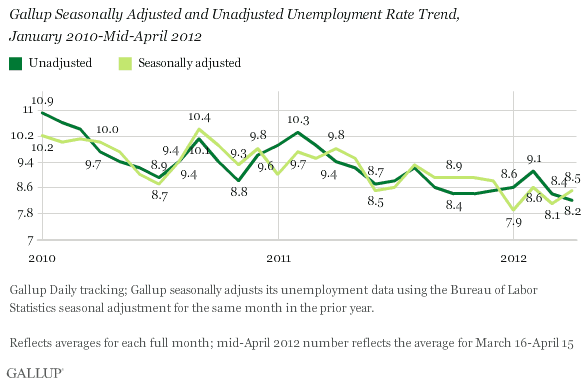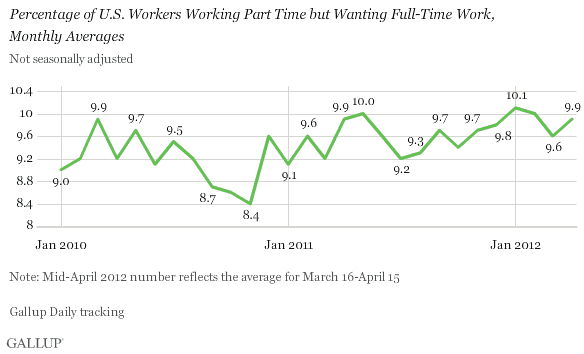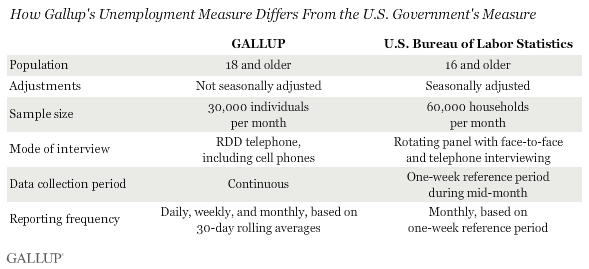PRINCETON, NJ -- U.S. unemployment, as measured by Gallup on a preliminary basis without seasonal adjustment, declined to 8.2% in mid-April from 8.4% in March. However, the government's likely seasonal adjustment of 0.3 percentage points leads to a Gallup seasonally adjusted U.S. unemployment rate of 8.5% in mid-April, up from 8.1% last month.

These results are based on Gallup Daily tracking interviewing conducted from March 16-April 15, including interviews with 31,283 U.S. adults, 67.9% of whom are active in the workforce. Gallup's seasonally adjusted unemployment rate is based on the adjustment the Bureau of Labor Statistics uses in the same month of the previous year.
On an unadjusted basis, the unemployment rate, if the mid-April reading is sustained for the rest of the month, would reach a new low since Gallup began monitoring and reporting U.S. unemployment rates in January 2010. The current low for the unadjusted monthly rate is 8.4%, reached in October and November 2011, and again in March of this year.
Applying the government's seasonal correction factor from April 2011 (+0.3 points) to the current mid-April data yields a seasonally adjusted estimate of 8.5% unemployment, up from March. This is much higher than the 7.9% seasonally adjusted monthly low for Gallup's U.S. unemployment rate, seen in January of this year. If it holds, it could also indicate a significant reversal in the recent downward trend of the government's seasonally adjusted unemployment rate.
Regardless, Gallup data show that unemployment is far below year-ago levels. April's preliminary unadjusted unemployment rate is down 1.2 points from April 2011 and the adjusted unemployment rate is down 1.3 points year-over-year.
Working Part Time but Wanting Full-Time Work Same as April 2011
The percentage of Americans working part time but looking for full-time work is 9.9% in mid-April, matching the reading of April 2011 and up slightly from 9.6% in March 2012, on an unadjusted basis.

Underemployment Unchanged
Gallup's U.S. underemployment measure, which combines unemployed workers with those working part time but looking for full-time jobs, is 18.1% in mid-April, compared with 18.0% in March. The underemployment rate declined to as low as 18.0% last July but rose in August. It climbed to 19.1% in February before plunging last month.

Implications
Gallup's unadjusted unemployment rate fell to 8.2% in mid-April from March's 8.4%. A decline in April is expected on an unadjusted basis even when the economy is growing modestly, because hiring activity normally picks up at this time of year. Last year, Gallup's unadjusted unemployment rate fell 0.5 points over the full month of April. Given last year's decline and the sharp decline that took place this year during the last half of March, it seems possible that the unadjusted unemployment rate will fall further later this month.
On the other hand, the government's April 2011 seasonal adjustment of +0.3 points, when applied to Gallup's mid-month figure, suggests that the seasonally adjusted unemployment rate could currently be 8.5% -- up from the government's 8.2% report last month. If this situation holds for the remainder of April, it would likely mean an increase in the government's seasonally adjusted rate. It would also tend to support the idea that some of the decline in the unemployment rate earlier this year was borrowed from the second quarter as a result of unusually warm weather and this year's relatively early Easter.
Overall, it doesn't seem as if the downward trend in the seasonally adjusted unemployment rate is continuing to gain momentum, at least as of mid-April. That is, the improvement in the job situation is not as strong as last year's seasonals imply is needed to maintain the downward momentum in the unemployment rate. This is consistent with the current modest rate of overall economic growth. It also leaves the unemployment rate exposed to further increases if the U.S. workforce grows substantially in the months ahead because job growth may not accelerate.
Even as the downward momentum in unemployment seems to be leveling off, it is worth noting that the jobs situation remains far better this April than it was in April a year ago. Gallup's seasonally adjusted U.S. unemployment rate was 9.8% and unadjusted underemployment was 19.3% in April 2011.

Gallup.com reports results from these indexes in daily, weekly, and monthly averages and in Gallup.com stories. Complete trend data are always available to view and export in the following charts:
Daily: Employment, Economic Confidence, Job Creation, Consumer Spending
Weekly: Employment, Economic Confidence, Job Creation, Consumer Spending
Read more about Gallup's economic measures.
View our economic release schedule.
Survey Methods
Results are based on telephone interviews conducted as part of Gallup Daily tracking from March 16-April 15, 2012, with a random sample of 31,283 adults, aged 18 and older, living in all 50 U.S. states and the District of Columbia, selected using random-digit-dial sampling.
For results based on the total sample of national adults, one can say with 95% confidence that the maximum margin of sampling error is ±1 percentage point.
Interviews are conducted with respondents on landline telephones and cellular phones, with interviews conducted in Spanish for respondents who are primarily Spanish-speaking. Each sample includes a minimum quota of 400 cell phone respondents and 600 landline respondents per 1,000 national adults, with additional minimum quotas among landline respondents by region. Landline telephone numbers are chosen at random among listed telephone numbers. Cell phone numbers are selected using random-digit-dial methods. Landline respondents are chosen at random within each household on the basis of which member had the most recent birthday.
Samples are weighted by gender, age, race, Hispanic ethnicity, education, region, adults in the household, and phone status (cell phone only/landline only/both, cell phone mostly, and having an unlisted landline number). Demographic weighting targets are based on the March 2011 Current Population Survey figures for the aged 18 and older non-institutionalized population living in U.S. telephone households. All reported margins of sampling error include the computed design effects for weighting and sample design.
In addition to sampling error, question wording and practical difficulties in conducting surveys can introduce error or bias into the findings of public opinion polls.
For more details on Gallup's polling methodology, visit www.gallup.com.
